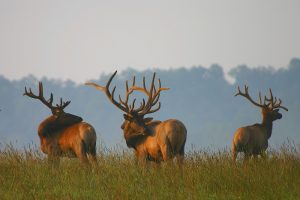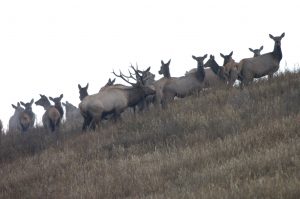
Photo: Kentucky Department Fish and Wildlife
Hunters interested in entering this year’s elk hunt drawing have until midnight (EST) April 30 to buy applications. Hunters can apply online at the department’s website, fw.ky.gov.
Kentucky residents and non-residents are eligible to apply for four permit types but can only be drawn for one. Each application costs $10.
Kentucky Fish and Wildlife will issue 700 general quota hunt permits and 10 youth permits this year through a random computer drawing conducted in early May by the Kentucky Commonwealth Office of Technology. Results will be available to applicants on the department’s website May 15.
Sixty-four percent of bull elk hunters using a gun last year enjoyed a successful hunt and 48 percent of hunters utilizing archery equipment successfully harvested a bull. The success rate for cow archery hunters was 28 percent last year and 47 percent among hunters using a firearm for cow elk.
“Our herd is strong and healthy,” said Gabe Jenkins, deer and elk program coordinator with the Kentucky Department of Fish and Wildlife Resources. “However, the herd dynamics have changed in recent years. Hunters will have to work to be successful and time spent scouting will greatly increase chances for success.”
The season limit of 250 bulls and 450 cow elk is unchanged from last year, as is the allotment among tag types.
Kentucky Fish and Wildlife will issue 150 firearms permits and 100 archery/crossbow permits for bulls; 290 firearms permits and 160 archery/crossbow permits for cow elk.
Demand is greatest for the bull firearms permit and lowest for the cow archery hunts.
The bull archery/crossbow season opens in September. The bull elk firearms seasons are spread over two separate, weeklong hunts in October while the cow elk firearms seasons are split into two weeklong hunts, both in December.
Hunters ages 15 and younger also can apply for the youth-only quota hunt during the same application period as the general elk quota hunt drawing. They may apply for the general quota elk hunt drawing as well, but cannot be drawn for both in the same year.
A landmark restoration effort re-established an elk herd in the state’s scenic southeastern region and created one of the most sought-after hunting opportunities east of the Rocky Mountains. Kentucky’s elk herd is the largest east of the Rocky Mountains and more than all the states east of the Mississippi River combined. The elk restoration zone in southeast Kentucky covers 16 counties and more than 4 million acres.

Elk photos from Starfire WMA Oct. 27, 2005. Photos taken by Dave Baker.
The Kentucky Fish and Wildlife Commission modified the elk voucher cooperator and elk restoration permit program and boating regulations at its quarterly meeting Sept. 8.
The Commission recommends all hunting, fishing and boating regulations for approval by the General Assembly and approves all expenditures by the Kentucky Department of Fish and Wildlife Resources. All recommendations must be approved by legislators before they become law.
In wildlife-related business, the Commission proposed modifying the point system used for the Voucher Cooperator Elk Permit and the Elk Restoration Permit programs in an effort to increase landowner participation. Commissioners voted to reduce the number of points needed by participating landowners to receive an elk permit. Commission members also recommended requiring elk guides to report elk wounded by clients.
In other wildlife-related business, commissioners proposed adding a third quota fox hunting field trail at Clay Wildlife Management Area (WMA) in Nicholas County for the last weekend in February. They also recommended changes to testing and permitting requirements for falconry.
In boating-related business, the commission recommended creating a maximum centerline length of 24 feet for monohull boats with seating for at least eight passengers on the following lakes: Guist Creek Lake in Shelby County, Cedar Creek Lake in Lincoln County, Lake Beshear in Caldwell and Christian counties and Lake Malone in Muhlenberg, Todd and Logan counties.
If approved by legislators, the boating regulation proposed at the meeting would take effect March 1, 2018.
The next Kentucky Fish and Wildlife Commission meeting is currently scheduled for 8:30 a.m. (Eastern time), Friday, Dec. 8, 2017. Meetings are held in Frankfort at Kentucky Fish and Wildlife headquarters, 1 Sportsman’s Lane. Commission meetings are open for the public.

Photo: Kentucky Department Fish and Wildlife
The Kentucky Department of Fish and Wildlife Resources is extending the deadline to apply for a 2017 Kentucky elk hunt due to unexpected technical problems with the state-run computer network that processes applications. The deadline to apply for Kentucky’s elk hunts will now close at 11:59 p.m. (Eastern time) Wednesday, May 3.
Kentucky’s online application system shut down at 9:05 p.m. Sunday, April 30. It remained shut down past the midnight deadline for the elk drawing. Kentucky Fish and Wildlife officials extended the deadline for those who were unable to apply in the waning hours of the application period.
Those who applied prior to the network shutdown were not affected.
The application period normally ends at midnight, April 30. However, state regulation allows for this period to be extended if technical difficulties prevent applications from being accepted.
Hunters may apply only online at the Kentucky Fish and Wildlife website – fw.ky.gov. Those who previously applied for an elk hunt may confirm their application by checking the “My Profile” page on the website.
The elk lottery drawing for an elk permit is open to residents and non-residents.
 Weather
Weather Traffic
Traffic @LouisvilleDispatch
@LouisvilleDispatch @LouisvilleDisp
@LouisvilleDisp Subscribe
Subscribe